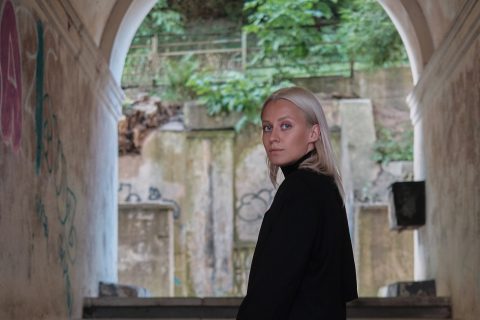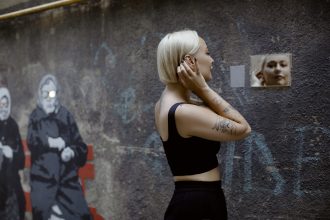In the winter, I visited the house-museum of optical art creator Kazys Varnelis located in Vilnius. One of its spaces featured an exhibition called Ethnographic Op Art: Textile Art Tradition. In it, I saw exhibits that somehow brought me back to my childhood, the village, because they reminded me of the fabrics my grandmother used to cover the beds with. Later I learned about the work of the artist, and costume designer Inga Skripka and the project My Historical Grandmother’s Mode of Life. In it, authentic old textiles are reborn as modern clothing, thus building a bridge between the past and the future. It brought back even more fond memories and questions!
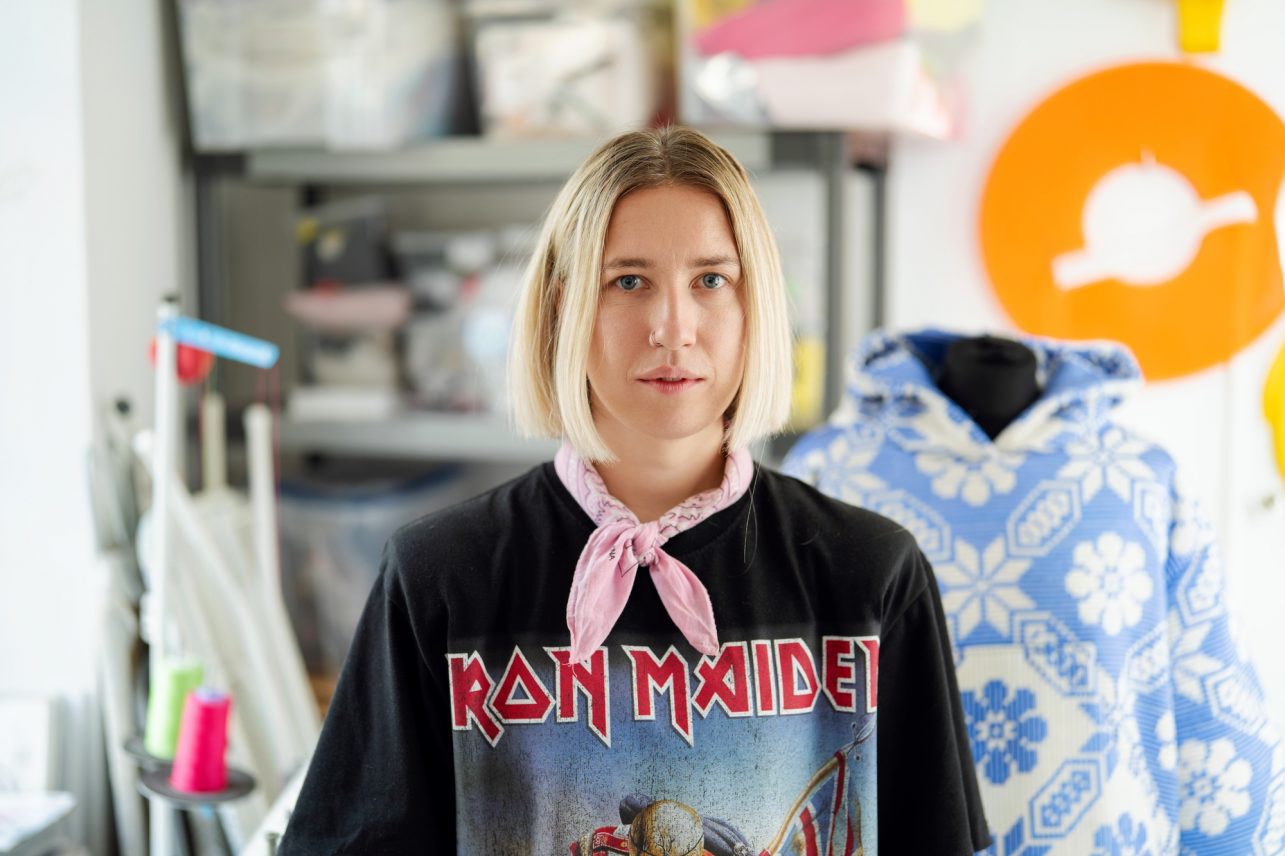
Inga, tell us how fashion design came into your life.
I think it came through the theatre. I remember going to see a play called Seagull when I was a teenager. Immediately after that, I became obsessed with theatre. I visited all the performances that were shown at that time, and there were no exceptions. Sometimes I think that it was then that I touched the heart of the theater. Both good and bad performances influenced me, and I thought that I would like to be there too. I didn’t try to figure out what I could do there, I only knew it would not be acting. I was attracted to the totality that is broadcast from the stage during the performance.
Of course, several other life episodes probably contributed as well. For example, when a friend decided to make his own school graduation suit. He found a sewing course and I tagged along, although I didn’t plan on doing anything serious, I just wanted to have a good time. I was so interested in the whole process that I received a sewing machine as a gift. That’s how the puzzle began to fall into place – I realized that I wanted to become a theater costume designer.
Guided by that idea, I went to the Vilnius Academy of Arts. Of course, not everything went as planned. I freaked out at the last moment and chose painting. After my studies, I went abroad, strengthened my knowledge, and then returned to my original plan: I found myself in the theatre and started creating costumes for plays.
Have you ever thought about plan B?
I had. After all, creative work is a volatile field, constantly changing and not always according to plan. Sometimes I think that I live a double life because many people only know me as a designer or an artist. In addition, I have a sushi truck with my friend, and I also occasionally work with advertising agencies. To be more precise, in the costume department. These additional jobs are interesting to me, but I don’t have big ambitions, it’s just plan B so that I can work on plan A more comfortably.
What does your typical working day look like?
Lately, my workdays have not been typical. I’ve lost the routine and the ability to plan my days, but the one thing that the regular change hasn’t devoured yet is a slow morning. If I must start work early in the morning, I will then get up even earlier just to have a slow morning.
Is fashion design a profession or a way of life for you?
Both, but I try to look at creative work very carefully so that it would not swallow me. Of course, I would like to live comfortably so that the day could flow poetically downstream, but I don’t know how honest I would be with myself then. I don’t run away from anything, I let everything develop naturally. Sometimes I give in to adventures just so I can continue to improve and find my own way. This way you can check yourself and understand who you are and with whom you want to walk down this creative path.
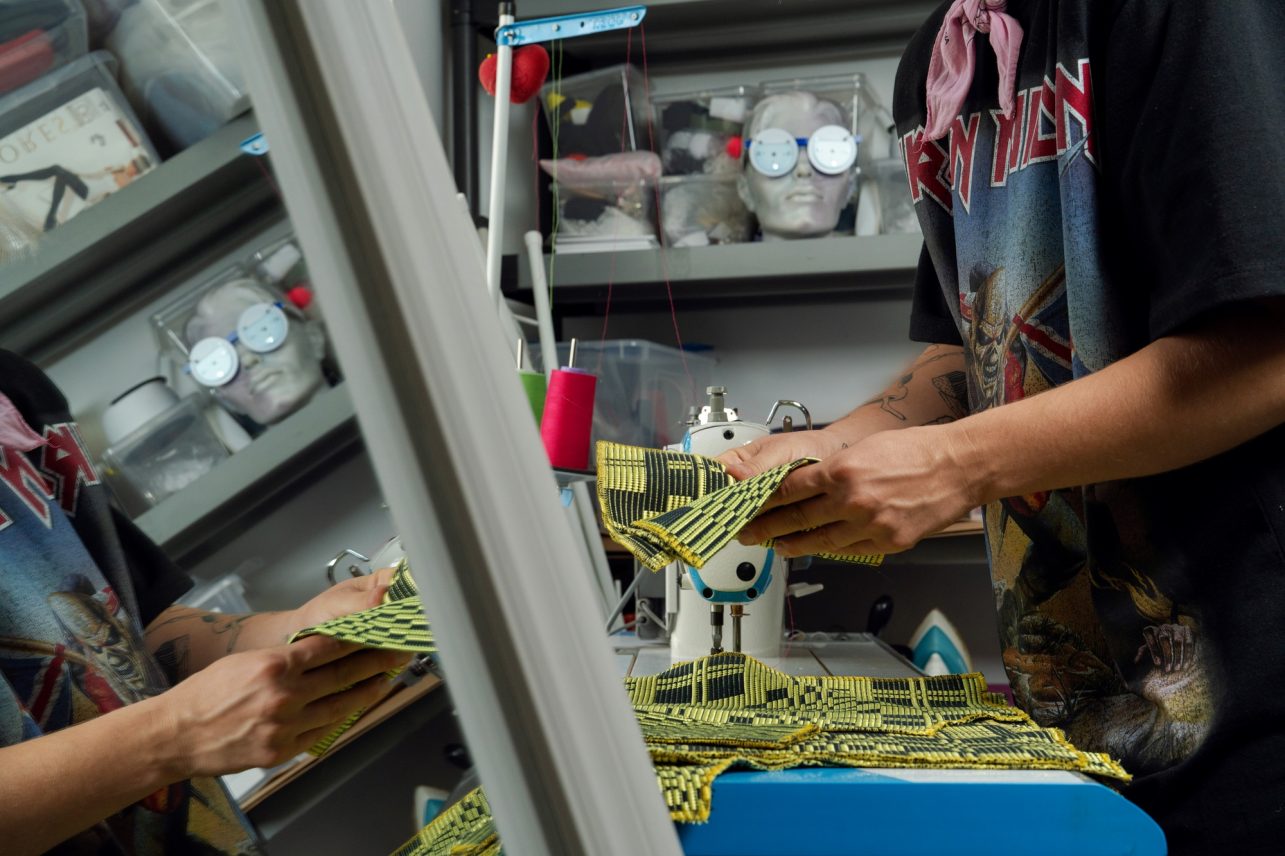
Let’s talk about one of your latest collections: My Historical Grandmother’s Mode of Life. Both of your grandmothers come from the same village and lived close to each other near Stakliškės. And one of them – Marcelė – encouraged you to undertake this project.
It’s quite difficult to describe how those steps came together, but now, after a considerable amount of time has passed, I can say that things could have easily gone the other way. I had a grandmother who wove, and she gifted me some of her work, so I just had to become mature enough to notice and appreciate her creations. Personally, I still don’t understand weaving. Everything seems very complicated, although my grandmother in Stakliškės is trying to explain everything to me. It’s possible that finding out will take away that magic and charm. Maybe then I will stop working on this project.
The collection is dominated by hundred-year-old fabrics with traditional Lithuanian patterns, which you find in grandmothers’ chests or archives. Do people come to you with their own fabrics and ask you to create something special together, or do you try to keep the entire creative process to yourself?
In the beginning, as soon as it was born, this project was more of a story about Lithuanian heritage, which I told through my grandmother’s bedspreads. And in order to have something to tell, I had to look into Marcelė and her work. That’s when I heard stories that impressed me. Everything would have been even more magical if my grandmother had told me about weaving herself, unfortunately, she didn’t make it, so I had to collect the material by asking my mother all the questions. In the long run, I wanted to share the experience with others, so that they could also discover it, and learn more facts and stories about their own families. And if they wanted to, they would turn the historical fabric into an object or a piece of clothing.
Now people come to me with the fabrics woven by their grandmothers. I invite everyone because it’s part of the project. I would say that an exchange is taking place. I give my idea for a design in exchange for the story about that fabric’s origin. It is even better when I have the opportunity not only to get to know the story of the fabric but also to meet the woman who wove it. Such events are really rare, but for me, they are the biggest driver of this project.
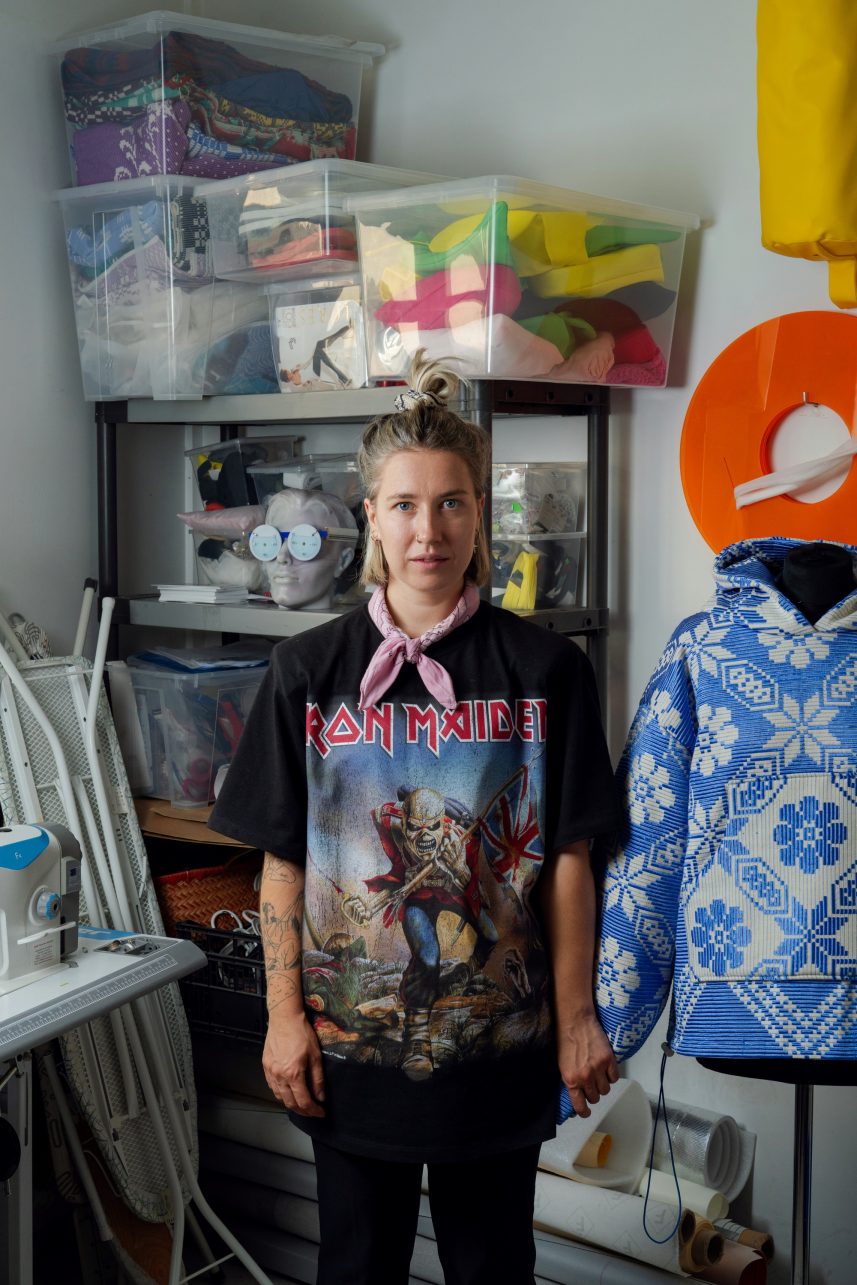
With My Historical Grandmother’s Mode of Life, you wanted to show the rich cultural heritage of Lithuania and compare tradition with the present. Tell me, what parallels did you notice?
It is true that Lithuanian traditions are rather inflexible, there is no attempt to adapt them to modern times, and they are presented quite conservatively. And I really don’t want everything to sink into oblivion. I agree, the foundations of traditions must remain as they are, but it is important to find ways to convey them in other ways that would pique the interest of people today. After all, the essence of all cultures is the transmission of these values from one generation to the next. Otherwise, the country’s culture may be doomed to collapse.
The main goal of My Historical Grandmother’s Mode of Life is to present our heritage in other ways, free it from conservatism, and arouse curiosity for future generations. I believe I succeeded in doing that. The goal was and still is to get the younger generation more interested – that’s what the focus was on. I am glad that today, different generations are interested in and support the project.
Inga, you are an artist, although the clothes you create look great both on the catwalk and in exhibition spaces. I wonder what is closer to your heart – creating clothes that can be worn by people or costumes that turn into sculptures?
Thank you! It’s not easy to answer this question, but I think that everything works out by itself. The runaway was never my ambition, it was the very beginning of my work that took me there. However, I don’t know if the catwalk allows me to convey my creative ideas. Of course, I’m glad I tried it, and I’m not saying I’m going to stop with that, but personally, I had more fun creating objects and using metaphors to convey my ideas while in the academy. I found it to be a broader field for creative eloquence to unfold.
When I started working with My Historical Grandmother’s Mode of Life, I realized that I was starting again, I was trying to express myself in another space, creating objects and then installing them into clothes. Now I seem to be on the path where I have the possibility to be curious and look for new forms. At one point I was confused and gave myself an ultimatum to decide who I was: an artist or a clothing designer. That thing is still gnawing at me, but much less, because I realized that I should stop putting this pressure on myself and focus on creative work instead of trying to squeeze myself in a box.
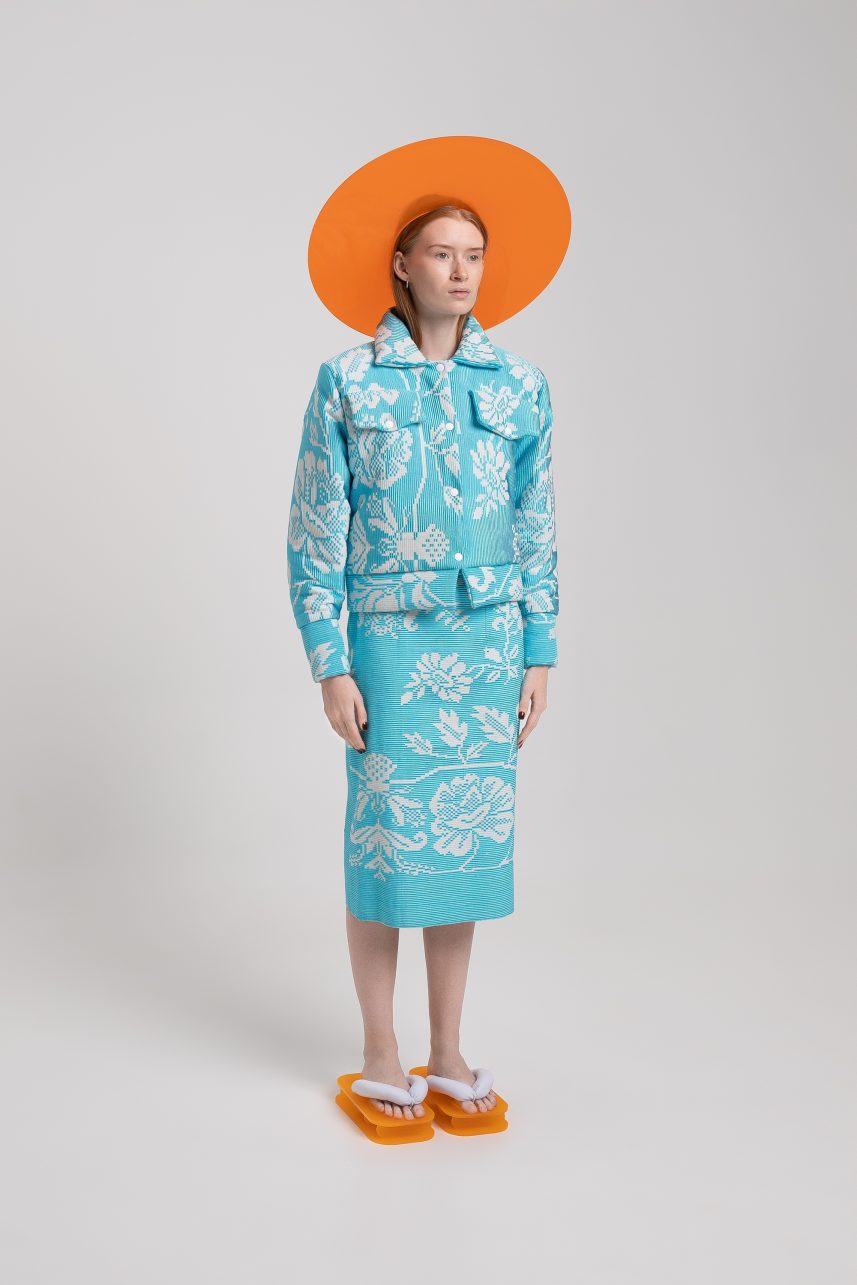
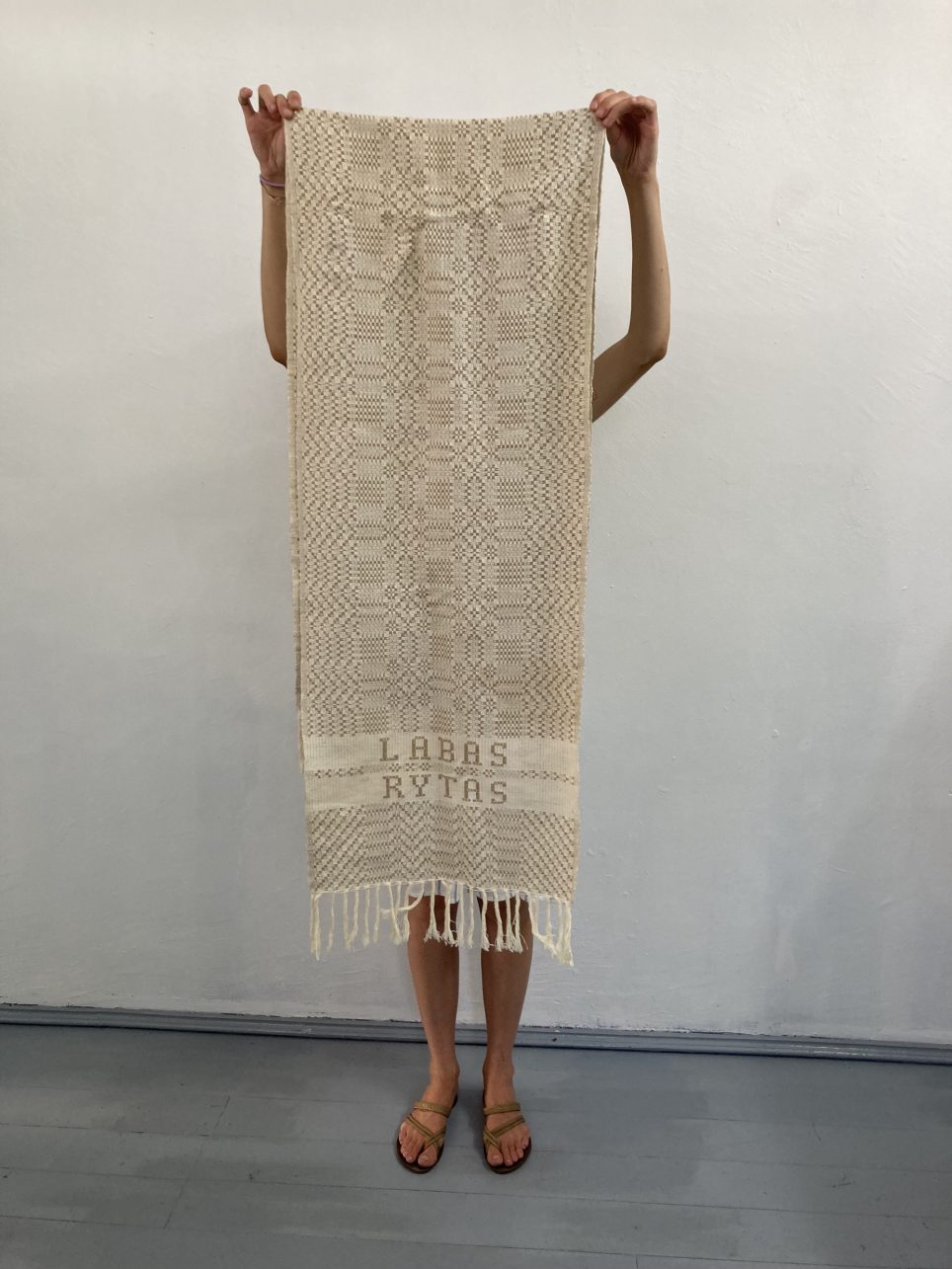
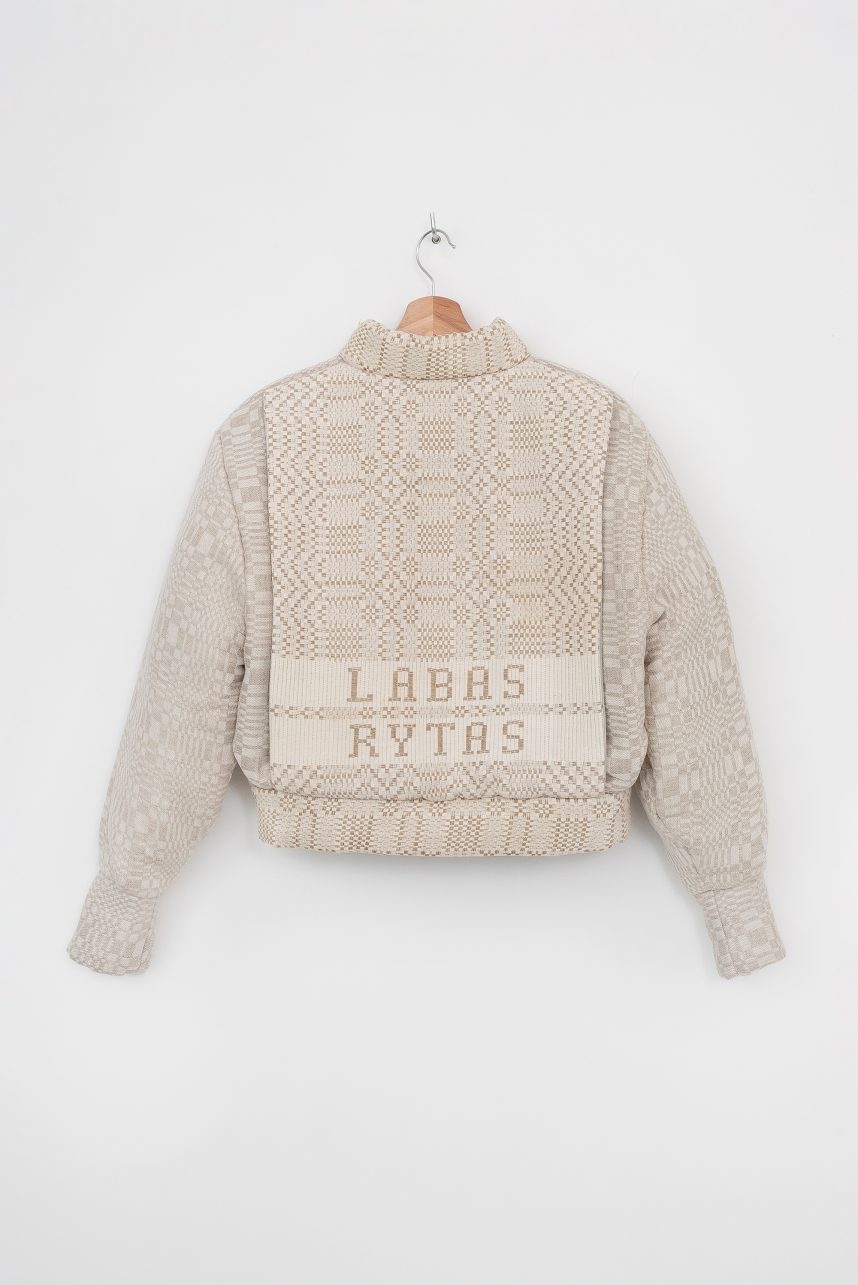
On your social media account, you talked about a towel with the “Good morning” inscription, which one of your clients brought back from her mother’s homestead. It turns out that it was a cloth given to her mother by a crush many years ago. Have there been any other similarly interesting events throughout the journey of this collection that you would like to share?
I call this story the first SMS to your crush. Apparently, it’s about love. A woven fabric of rare beauty arrived in the studio, the likes of which I have not seen before. The patterns and fabric composition seemed too luxurious for that period. Wool both itched and warmed like no other woven fabric I had ever seen. It came from Aukštaitija, thanks to my client Martyna. Her grandfather was a village matchmaker. She said that neighbors often approached him and asked him to do matchmaking because they believed he had a good eye for it, for which he was rewarded with the said fabric. I don’t know the whole story, but I can tell from the gift that the grandfather did a better job than expected. I was so impressed with the fabric that I even tried to dissuade Martyna from cutting it.
In the documentary series called Vizionieriai (visionaries) fashion journalist Deimantė Bulbenkaitė said that you are able to build a very interesting bridge between the past and the future, but at the same time, you reflect the present very well. What is your present about?
I am currently traveling around Lithuania and collecting material about current or former weavers and their grandchildren. In August, I will present a fragmentary exhibition of what I managed to collect, but this is not the end. The purpose of the collected material is to publish a catalog, but at the same time, I am spinning new ideas and looking for new topics for other projects.


